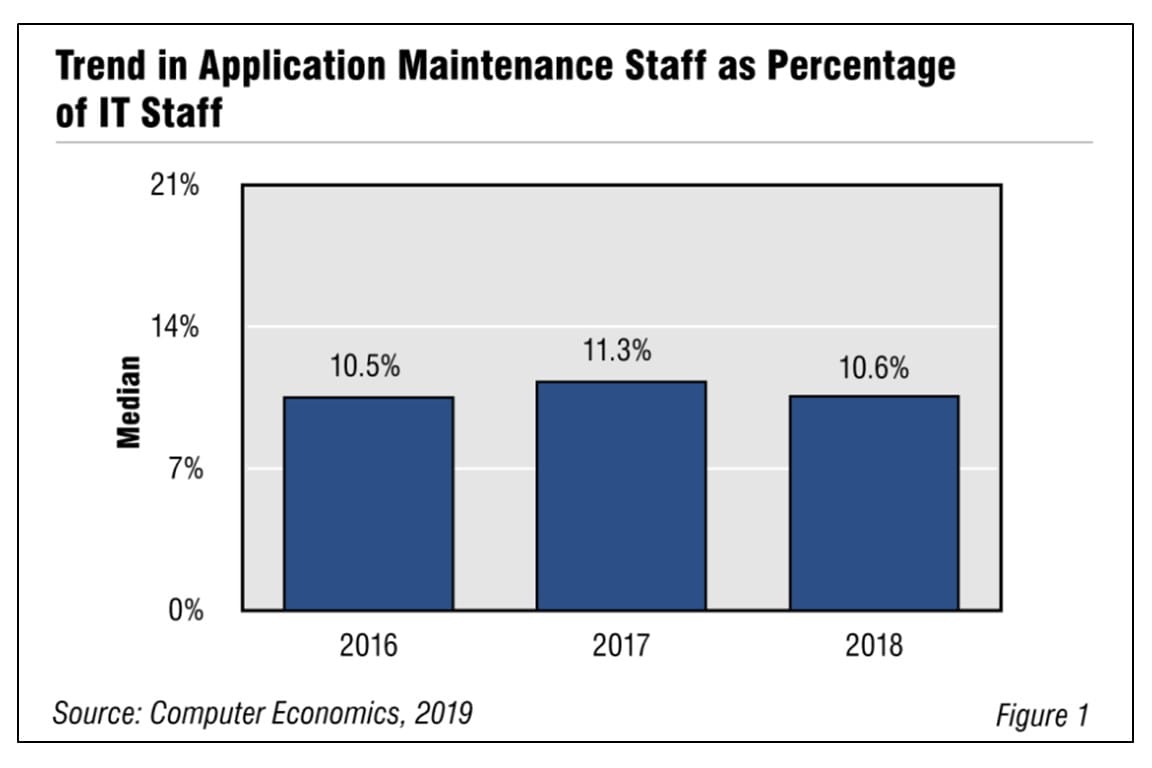Latest Reports
-

Business Analyst Staffing Ratios 2021
Business analysts as a percentage of the IT staff has risen from its previous decline, and we expect that this will be the trend. The business analyst serves as a bridge between the IT organization and business users. It is a multifaceted role that is important for ensuring that IT application systems meet business objectives. In this study, we assess staffing levels for the business analysts using four metrics: business analysts as a percentage of the IT staff, business analysts as a percentage of the delivery group, applications per business analyst, and users per business analyst. We also present ratios by organization size and sector.
November, 2021
-

Help Desk Staffing Ratios 2021
The help desk not only plays a key role in maintaining user productivity, but it also serves as the day-to-day face of the IT organization. This report provides staffing benchmarks for the help desk (service desk). We look at the trend in help desk staffing over a five-year period and provide five benchmarks by organization size and sector: help desk staff as a percentage of the IT staff, users per help desk staff member, applications per help desk staff member, first-call resolution rate, and help desk tickets per end-user support staff member. Because companies organize the end-user support function in different ways, we also provide benchmarks for a combined help desk and desktop support staff. We conclude with recommendations on optimizing help desk staffing levels.
October, 2021
-

Database Administration Staffing Ratios 2021
As enterprises collect more data and connect more applications, they must ensure that data is secure, reliable, and accessible. But despite these increased demands, companies are restraining the growth in their database administration staff. This report helps IT managers determine whether they are keeping pace with industry standards by providing four benchmarks: database administrators (DBAs) as a percentage of the IT staff, DBAs as a percentage of the Data Center Group, users per DBA, and business applications per DBA. We present benchmarks for small, midsize, and large organizations and examine the influence by sector on these benchmarks. We conclude with best practices for optimizing DBA staffing.
October, 2021
-

IT Project Management Staffing Ratios 2021
In this study, we assess how many project managers a typical IT organization requires. We present five benchmarks: project managers as a percentage of the IT staff, project managers as a percentage of the application group, users per project manager, applications per project manager, and application programmers per project manager. Our analysis also includes the influence of organization size and industry sector. We conclude with recommendations on assessing the performance of the project management function.
May, 2021
-

Communications System Support Staffing Ratios 2021
Corporate communications systems have become more complex, although the number of IT specialists who support these systems has stabilized in the past few years. Because of the COVID-19 pandemic and other factors, IT organizations can benefit from a periodic assessment of their communications system support staffing levels. This study uses three metrics to make that assessment: support staff as a percentage of the IT staff, percentage of support staff in relation to organization size, and support staff spending per user. We provide benchmarks for the composite sample, by organization size, and by sector.
January, 2021
-

Application Developer Staffing Ratios 2021
The way that enterprise applications are internally developed and maintained has changed. With these changes, the need for application developers is in flux, and IT organizations can benefit from a periodic assessment of their staffing levels. This report uses three metrics to make that assessment: developers as a percentage of the IT staff, users per developer, and applications per developer. We provide benchmarks for the composite sample, by organization size and by sector. We also provide a benchmark for the larger Application Group, which includes personnel engaged in web development and support, quality assurance, data management, and business systems analysis.
February, 2021
-

Trends in Telecommuting in the IT Workforce 2020
The practice of working remotely has skyrocketed over the past 11 years for many reasons, and in early 2020 it got a huge boost with growing concerns about the COVID-19 coronavirus. This report examines the reasons for the rise in telecommuting, how often IT workers do so, and what benefits companies and employees are enjoying—while also being mindful of possible disadvantages. We conclude with best-practice recommendations for a sound telecommuting policy. (10 pp., 4 fig.)
March, 2020
-

ERP Support Staffing Ratios 2021
For many IT organizations, enterprise resource planning (ERP) systems are at the center of the application portfolio. In this report, we analyze ERP support requirements in several ways. First, we look at the ERP support staffing ratio, which is the number of ERP users divided by the number of ERP support personnel. We then assess this ratio by the size of the ERP installation. We also examine the data to determine the ratios by vendor. We examine the ratio by sector, age of installation, years since last upgrade, extent of modification, and type of deployment (on-premises, cloud, or hosted) as well. Finally, we provide recommendations on optimizing ERP staffing levels. (20 pp., 10 fig.)
January, 2021
-

Worldwide IT Spending and Staffing Outlook for 2020
Although IT leaders worldwide have a positive outlook for the global economy, that outlook seems a bit tinged with frustration compared to previous years. This report, based on our Q4 survey, provides data on the global and U.S./Canadian trends for IT spending and staffing in 2020. This year, our report assesses IT operational and capital spending plans, executive priorities for IT investment, and plans for hiring, outsourcing, and pay raises for IT organizations worldwide and in the U.S. and Canada. (34 pp., 24 fig.)
January, 2020
-

Application Maintenance Staffing Ratios 2019
As an organization’s application portfolio grows, the application maintenance role becomes a more critical function and IT organizations can benefit from periodic assessment of their staffing levels. This report uses three metrics to make that assessment: application maintenance staff as a percentage of the IT staff, users per application maintenance staff member, and applications per application maintenance staff member.
March, 2019
-

IT Management and Administration Staffing Ratios 2019
When it comes to IT managers, it is important to find the sweet spot. Too many, and the IT group can become top-heavy and bureaucratic, while too few can leave IT staff members feeling unsupported and without direction. This report examines how many IT managers a well-run IT organization typically requires, along with staffing metrics for two related administrative functions: IT finance/vendor management and clerical support.
August, 2019
-

Application Developer Staffing Ratios 2019
With the use of agile and advent of DevOps, the way that applications are being developed in the enterprise is changing. With these changes, the need for application developers is in flux, and IT organizations can benefit from periodic assessment of their staffing levels. This study uses three metrics to make that assessment: developers as a percentage of the IT staff, users per developer, and applications per developer.
November, 2019



















